MARCONI
EXHIBIT NOW ON DISPLAY
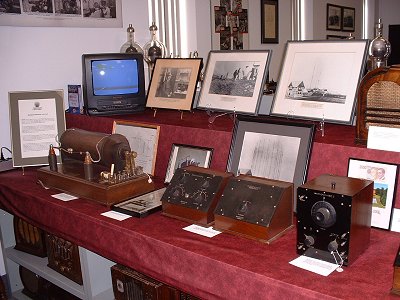 The museum has a special exhibit dedicated to
Marconi. The exhibit includes a video on Marconi, brochure
detailing the story behind the event, artefacts manufactured by
Canadian Marconi Company, photographs and magazine articles. The museum has a special exhibit dedicated to
Marconi. The exhibit includes a video on Marconi, brochure
detailing the story behind the event, artefacts manufactured by
Canadian Marconi Company, photographs and magazine articles.
Nori
Irwin VE3AQZ
Museum Curator

In May of 1898 a 24
year old man by the name of
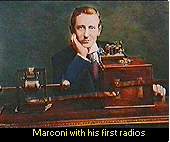 GUGLIELMO
MARCONI registered Patent 7777 since which the world of radio
communications has not looked back. This breakthrough added tuning
circuits to guarantee the independence of simultaneous communications
between more than one station. GUGLIELMO
MARCONI registered Patent 7777 since which the world of radio
communications has not looked back. This breakthrough added tuning
circuits to guarantee the independence of simultaneous communications
between more than one station.
On November 26, 1901 MARCONI
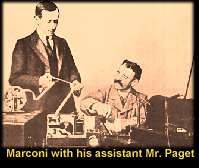 with
his two assistants PAGET and KEMPT embarked in Liverpool for St.
John's where they built another radio station. Marconi bought out the
complete inventory of Peto and Radford English storage batteries from
John Millen and Son in Montreal and had them shipped to Glace Bay. A
few days later on on December 12th 1901 around 12.30, local time,
MARCONI received three weak signals, 'dit' 'dit' 'dit' corresponding
to letter S in MORSE code. with
his two assistants PAGET and KEMPT embarked in Liverpool for St.
John's where they built another radio station. Marconi bought out the
complete inventory of Peto and Radford English storage batteries from
John Millen and Son in Montreal and had them shipped to Glace Bay. A
few days later on on December 12th 1901 around 12.30, local time,
MARCONI received three weak signals, 'dit' 'dit' 'dit' corresponding
to letter S in MORSE code.

 For
the first time in the world electromagnetic waves had crossed an ocean
and the rest is history which has been perfectly restored at the
Hammond Museum of Radio. For
the first time in the world electromagnetic waves had crossed an ocean
and the rest is history which has been perfectly restored at the
Hammond Museum of Radio.
This Marconi 10 inch spark transmitter was built and used at the
turn of the century and is identical to the transmitter used on the
Titanic to send the first SOS.
Matching receivers of the era would have been this Canadian Marconi
crystal detector model that depicts the impress and robust
construction of the time.
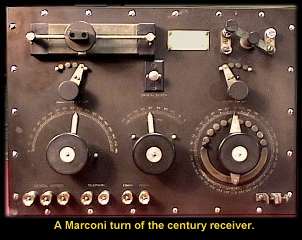
The crystal selection switch is visible at the top right. If one of
the crystal connections became unstable the operator could quickly
switch to hopefully a more stable piece of raw quartz wedged into the
four machined retaining slots.
These Marconi radios where similar to those used aboard the Titanic
on it's fateful Atlantic crossing and were recreated by the production
company using Styrofoam for use in the the Titanic's Radio Room.
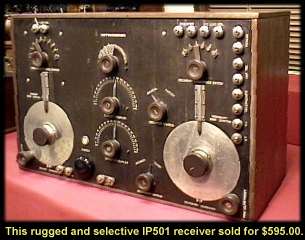 Other
manufacturers were quick to licence Marconi's technology. One of the
high end commercial receivers of the time was the IP501 pictured here
in almost factory new condition. For improved performance, this
receiver featured an input for an external detector. Other
manufacturers were quick to licence Marconi's technology. One of the
high end commercial receivers of the time was the IP501 pictured here
in almost factory new condition. For improved performance, this
receiver featured an input for an external detector.
Period advertisements for this beauty indicated the 501's weight
was 87 pounds and carried a retail price for $595.00 which equalled
the cost of two new family sedans.
Next
|
[ Top
] |
Last
updated
November 10, 2011
©
1998 - 2004 Hammond Museum of Radio
|
|
|
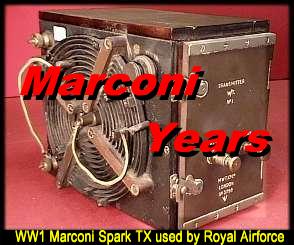

 The museum has a special exhibit dedicated to
Marconi. The exhibit includes a video on Marconi, brochure
detailing the story behind the event, artefacts manufactured by
Canadian Marconi Company, photographs and magazine articles.
The museum has a special exhibit dedicated to
Marconi. The exhibit includes a video on Marconi, brochure
detailing the story behind the event, artefacts manufactured by
Canadian Marconi Company, photographs and magazine articles.  GUGLIELMO
MARCONI registered Patent 7777 since which the world of radio
communications has not looked back. This breakthrough added tuning
circuits to guarantee the independence of simultaneous communications
between more than one station.
GUGLIELMO
MARCONI registered Patent 7777 since which the world of radio
communications has not looked back. This breakthrough added tuning
circuits to guarantee the independence of simultaneous communications
between more than one station. with
his two assistants PAGET and KEMPT embarked in Liverpool for St.
John's where they built another radio station. Marconi bought out the
complete inventory of Peto and Radford English storage batteries from
John Millen and Son in Montreal and had them shipped to Glace Bay. A
few days later on on December 12th 1901 around 12.30, local time,
MARCONI received three weak signals, 'dit' 'dit' 'dit' corresponding
to letter S in MORSE code.
with
his two assistants PAGET and KEMPT embarked in Liverpool for St.
John's where they built another radio station. Marconi bought out the
complete inventory of Peto and Radford English storage batteries from
John Millen and Son in Montreal and had them shipped to Glace Bay. A
few days later on on December 12th 1901 around 12.30, local time,
MARCONI received three weak signals, 'dit' 'dit' 'dit' corresponding
to letter S in MORSE code. For
the first time in the world electromagnetic waves had crossed an ocean
and the rest is history which has been perfectly restored at the
Hammond Museum of Radio.
For
the first time in the world electromagnetic waves had crossed an ocean
and the rest is history which has been perfectly restored at the
Hammond Museum of Radio.
 Other
manufacturers were quick to licence Marconi's technology. One of the
high end commercial receivers of the time was the IP501 pictured here
in almost factory new condition. For improved performance, this
receiver featured an input for an external detector.
Other
manufacturers were quick to licence Marconi's technology. One of the
high end commercial receivers of the time was the IP501 pictured here
in almost factory new condition. For improved performance, this
receiver featured an input for an external detector.